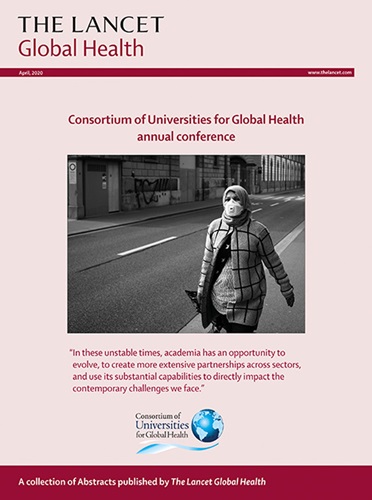The effectiveness, cost-effectiveness, budget impact, and return on investment of scaling up tuberculosis screening and preventive treatment in Brazil, Georgia, Kenya, and South Africa: a modelling study.
IF 19.9
1区 医学
Q1 PUBLIC, ENVIRONMENTAL & OCCUPATIONAL HEALTH
引用次数: 0
Abstract
BACKGROUND Closing the tuberculosis diagnostic gap and scaling up tuberculosis preventive treatment (TPT) are two global priorities to end tuberculosis. We aimed to estimate the cost-effectiveness, budget impact, and societal return on investment of a comprehensive intervention to improve tuberculosis screening and prevention in Brazil, Georgia, Kenya, and South Africa-four distinct epidemiological settings. METHODS In this modelling study, in partnership with national tuberculosis programmes we defined a set of interventions (the intervention package) related to tuberculosis screening and TPT in three priority populations: people with HIV, household contacts, and a country-defined high-risk population (people deprived of liberty [Brazil], people accessing care for injection drug use [Georgia], people in informal settlements in nine districts with a high prevalence of tuberculosis [Kenya], and people in the 22 subdistricts with the highest prevalence of tuberculosis [South Africa]). We developed transmission models calibrated to country-specific epidemiology and collated cost data for tuberculosis-related activities and patient costs in 2023 US dollars (US$). We compared the intervention package scaled up to reach all priority populations by 2030 to a status quo scenario based on projected tuberculosis epidemiology over a 27-year time horizon (Jan 1, 2024, to Dec 31, 2050); to delineate the impact of intervention components, we also evaluated the intervention package without TPT. Outcomes were health system and societal costs, number of tuberculosis episodes, tuberculosis deaths, and disability-adjusted life years (DALYs). We calculated the budget impact, health system cost per DALY averted, and societal return on the health system investment for each country. Outcomes were discounted at 3% per annum. FINDINGS With the status quo scenario, by 2050, tuberculosis incidence is projected to be 41 per 100 000 population (95% uncertainty range 32-53) in Brazil, 45 per 100 000 population (36-60) in Georgia, 214 per 100 000 population (146-266) in Kenya, and 261 per 100 000 population (133-406) in South Africa. The percentage of all tuberculosis episodes prevented by implementing the intervention package in all priority populations is projected to be 15·0% (12·8-17·5) in Brazil, 14·3% (13·1-15·8) in Georgia, 21·3% (15·2-27·6) in Kenya, and 26·4% (21·1-31·8) in South Africa by 2050. If implemented without TPT (ie, tuberculosis disease screening alone), corresponding reductions were lower at 10·4% (8·6-12·2) in Brazil, 10·2% (9·5-11·2) in Georgia, 12·6% (9·5-15·9) in Kenya, and 16·8% (13·0-20·4) in South Africa. In 2030, the percentage of the national tuberculosis programme budget required for the intervention package was 62% in Brazil, 10% in Georgia, 67% in Kenya, and 44% South Africa. The incremental cost per DALY averted of the intervention package compared with the status quo in all priority populations is $386 in Brazil, $491 in Georgia, $53 in Kenya, and $160 in South Africa. The corresponding societal return per health system dollar invested is projected to be $51 in Brazil, $8 in Georgia, $27 in Kenya, and $54 in South Africa. INTERPRETATION Scaling up tuberculosis screening and TPT requires substantial investment but is projected to be cost-effective compared with the status quo, to greatly reduce tuberculosis incidence, and to provide large returns on investment. FUNDING World Health Organization.巴西、格鲁吉亚、肯尼亚和南非扩大结核病筛查和预防性治疗的有效性、成本效益、预算影响和投资回报:一项模型研究。
背景缩小结核病诊断差距和扩大结核病预防治疗(TPT)是终结结核病的两项全球重点工作。在巴西、格鲁吉亚、肯尼亚和南非这四个不同的流行病学国家,我们的目的是评估改善结核病筛查和预防的综合干预措施的成本效益、预算影响和社会投资回报。方法:在本模型研究中,我们与国家结核病规划合作,在三个重点人群中定义了一套与结核病筛查和TPT相关的干预措施(干预包):艾滋病毒感染者、家庭接触者和国家定义的高危人群(被剥夺自由者[巴西]、因注射吸毒而获得护理的人[格鲁吉亚]、结核病高发地区9个非正式定居点的人[肯尼亚]、结核病高发地区22个街道的人[南非])。我们开发了根据具体国家流行病学校准的传播模型,并整理了以2023年美元计算的结核病相关活动和患者费用数据。我们将扩大到2030年覆盖所有重点人群的一揽子干预措施与基于27年时间范围(2024年1月1日至2050年12月31日)预测的结核病流行病学现状进行了比较;为了描述干预成分的影响,我们也评估了没有TPT的干预方案。结果是卫生系统和社会成本、结核病发作次数、结核病死亡人数和残疾调整生命年(DALYs)。我们计算了每个国家的预算影响、避免的每个DALY的卫生系统成本以及卫生系统投资的社会回报。结果以每年3%折现。研究结果:在目前的情况下,到2050年,预计巴西的结核病发病率为每10万人41例(95%不确定性范围32-53),格鲁吉亚为每10万人45例(36-60),肯尼亚为每10万人214例(146-266),南非为261例(133-406)。预计到2050年,在所有重点人群中通过实施一揽子干预措施预防的所有结核病发病率在巴西为15.0%(12.8 - 17.5),在格鲁吉亚为14.3%(13.1 - 15.8),在肯尼亚为21.3%(15.2 - 27.6),在南非为26.4%(21.1 - 31.8)。如果不进行TPT(即仅进行结核病筛查),相应的减少率在巴西为10.4%(8.6 - 12.2),在格鲁吉亚为10.2%(9.5 - 11.2),在肯尼亚为12.6%(9.5 - 15.9),在南非为16.8%(13.0 - 20.4)。2030年,干预方案所需的国家结核病规划预算比例在巴西为62%,在格鲁吉亚为10%,在肯尼亚为67%,在南非为44%。与所有重点人群的现状相比,干预方案避免的每DALY增量成本在巴西为386美元,在格鲁吉亚为491美元,在肯尼亚为53美元,在南非为160美元。预计每一美元卫生系统投资的相应社会回报在巴西为51美元,在格鲁吉亚为8美元,在肯尼亚为27美元,在南非为54美元。解释扩大结核病筛查和TPT需要大量投资,但预计与现状相比具有成本效益,可大大降低结核病发病率,并提供大量投资回报。资助世界卫生组织。
本文章由计算机程序翻译,如有差异,请以英文原文为准。
求助全文
约1分钟内获得全文
求助全文
来源期刊

Lancet Global Health
PUBLIC, ENVIRONMENTAL & OCCUPATIONAL HEALTH-
CiteScore
44.10
自引率
1.20%
发文量
763
审稿时长
10 weeks
期刊介绍:
The Lancet Global Health is an online publication that releases monthly open access (subscription-free) issues.Each issue includes original research, commentary, and correspondence.In addition to this, the publication also provides regular blog posts.
The main focus of The Lancet Global Health is on disadvantaged populations, which can include both entire economic regions and marginalized groups within prosperous nations.The publication prefers to cover topics related to reproductive, maternal, neonatal, child, and adolescent health; infectious diseases (including neglected tropical diseases); non-communicable diseases; mental health; the global health workforce; health systems; surgery; and health policy.
 求助内容:
求助内容: 应助结果提醒方式:
应助结果提醒方式:


